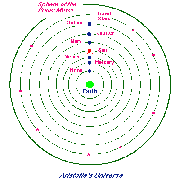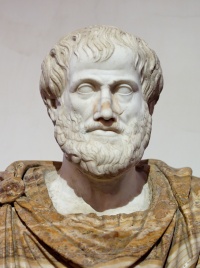Aristotle
From Geography
Aristotle (384-322 BC) was a great philosopher that lived in ancient Greece. He was a student of Plato and the mentor and teacher of Alexander the Great. Besides in philosophy, Aristotle was interested in many different subject areas, like (meta)physics, politics, ethics, biology and logic. Together with Plato and Socrates, Aristotle is one of the most important founders of modern Western philosophy.
This article will focus on Aristotle's specific notion of space. Until the discovery of Newtonian physics, these specific ideas profoundly shaped the way people perceived the world.
Contents |
Motion
One of Aristotle's special interests was the motion of objects. He asked himself why for example a rock falls and smoke rises. He also wondered why water flows down, while flames (fire) flare up into the air. To explain these observations, Aristotle stated that all matter in the universe was composed of five elements: fire, earth, air, water and aether. While the first four elements described the physical world, aether was used as a term to define everything that is beyond the physical world.
Aristotle believed that all four 'wordly' elements were part of a different natural realm. For example, humans lived on the border between the earth realm (the ground beneath our feet) and the air realm (the air all around us, up as high as we can see). Interestingly, Aristotle stated that the motion of objects was an attempt of these objects to reach their natural realm: a rock falls because it wants to be reunited with the earth realm and smoke rises because it consists of both air and fire and the air and fire realm are high up in the air.
Space

Aristotle argued that space was the resulting sum of places of all objects in the universe. This space was always subject to change, because all objects were in motion, trying to reach their natural resting state. 'Empty' space was a term that was not used by Aristotle: he considered the entire universe filled with the five elements that he described.
Considering his worldview, Aristotle made a clear distinction between the physical world and the non-physical world. He considered the earth to be the center of the universe, around which all celestial bodies circled. These bodies included the sun, the moon and all five planets known at that time (Mercury, Venus, Mars, Jupiter and Saturn). On the edge of the universe lied the stars, which had fixed positions. They marked the end of what Aristotle considered to be the entire physical universe. Aristotle believed that behind this physical universe was an infinite non-physical space: 'the heavens'.
This specific worldview profoundly influenced the notions of space that people had until the beginning of Renaissance. In the 16th century, this worldview was replaced by the Copernican model of the solar system. This means that Aristotle's ideas have formed the leading worldview for almost 2000 years.
Literature
Zimmerman Jones, A. Physics of the Greeks - The natural philosophy of Aristotle. Website: http://physics.about.com/od/physicshistory/a/GreekPhysics_2.htm, consulted March 27, 2013.
Author
--BartDirven 16:54, March 27, 2013 (CET)
Added picture --BartDirven 14:16, March 27 2013 (CET)
